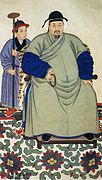Dahu (clothing)
| Dahu | |||||||
|---|---|---|---|---|---|---|---|
 Ming dynasty dahu, unearthed from the Tomb of Prince Zhu Tan. | |||||||
| Chinese name | |||||||
| Traditional Chinese | 褡護 | ||||||
| Simplified Chinese | 褡护 | ||||||
| |||||||
| Korean name | |||||||
| Hangul | 답호 | ||||||
| Hanja | 褡護/褡穫 | ||||||
| |||||||
Dahu (simplified Chinese: 褡护; traditional Chinese: 褡護; pinyin: Dāhù) was a form of robe/jacket which originated in the Ming dynasty.[1] In Ming dynasty, the dahu was either a new type of banbi (Chinese: 半臂; lit. 'half-arm') or a sleeveless jacket,[2][3] whose designs was influenced by the Mongol Yuan dynasty clothing.[1][3]
History
[edit]Yuan dynasty
[edit]In the Yuan dynasty, banbi were also referred as dahu in a broad sense but could also refer to a specific type of banbi of the same name, which is a half-sleeved long robe (changpao 长袍) with a cross-collar closing to the right (jiaoling youren 交领右衽).[4] This form of dahu (y-shaped collar long robe with short sleeves) was worn by the Mongols in the Yuan dynasty over long-sleeved robes in similar fashion as it was worn prior to the founding of the Yuan dynasty.[5]: 142 [6]: 43, 52
Ming dynasty
[edit]In the Ming dynasty, the dahu could be worn over the tieli robe and/or could be worn under the round-collar robe.[3][2] Some forms of dahu was bestowed to the Joseon Kings; for example, in 1444 under the rule of King Sejong of Joseon, the Ming dynasty bestowed him dahu, along with cheollik and gollyeongpo.[7][note 1] In the 21st century, the dahu, along with many forms of hanfu, was revived following the Hanfu movement.[8]
Construction and design
[edit]The dahu combined the features of the Tang and Song dynasties hanfu and the Mongol Yuan dynasty clothing.[3] The dahu was a cross-collar jacket which wrapped on the right side; it could be either short-sleeves or no-sleeves.[3]
Gallery
[edit]-
Portrait of a man wearing dahu and his servant, 17th century.
-
A man wearing a green dahu, a Ming dynasty painting.
-
Man wearing dahu, Ming dynasty.
Similar-looking garments
[edit]See also
[edit]Notes
[edit]References
[edit]- ^ a b Wei, Luo (2018-01-02). "A Preliminary Study of Mongol Costumes in the Ming Dynasty". Social Sciences in China. 39 (1): 165–185. doi:10.1080/02529203.2018.1414417. ISSN 0252-9203. S2CID 149138176.
- ^ a b "Ancient Chinese Robes for Men: Tieli & Yisan - 2020". www.newhanfu.com. 2020. Archived from the original on 2021-01-17. Retrieved 2021-05-24.
- ^ a b c d e "What is Da Hu - Chinese Traditional Male Clothing - 2021". www.newhanfu.com. 16 April 2021. Retrieved 2021-05-24.
- ^ 张, 国伟 (2013). "元代半臂的形制与渊源".
半臂又做半袖,到元代也称搭护。[...] 提出元代半臂的三种形制,即:直领短衫式半臂、交领右衽长袍式半臂(也称搭护)、方领对襟长袍式半臂
- ^ 5000 years of Chinese costumes. Xun Zhou, Chunming Gao, 周汛, Shanghai Shi xi qu xue xiao. Zhongguo fu zhuang shi yan jiu zu. San Francisco, CA: China Books & Periodicals. 1987. ISBN 0-8351-1822-3. OCLC 19814728.
{{cite book}}: CS1 maint: others (link) - ^ Shea, Eiren L. (2020). Mongol court dress, identity formation, and global exchange. New York, NY. ISBN 978-0-429-34065-9. OCLC 1139920835.
{{cite book}}: CS1 maint: location missing publisher (link) - ^ "철릭" [Cheollik]. 한국민속대백과사전 (in Korean). Retrieved 2022-03-24.
- ^ "Guide to Traditional Chinese Clothing - Hanfu". www.newhanfu.com. 2 November 2020. Retrieved 2021-05-24.
- ^ Do, Ju-Yeun; Kwon, Young-Suk (2001). "Costume Images of the Chosun Period′s Po for Men(Part I ) - Constituent factors, Type, Reflection of the Period -". Journal of the Korean Society of Clothing and Textiles. 25 (10): 1695–1706. ISSN 1225-1151.



